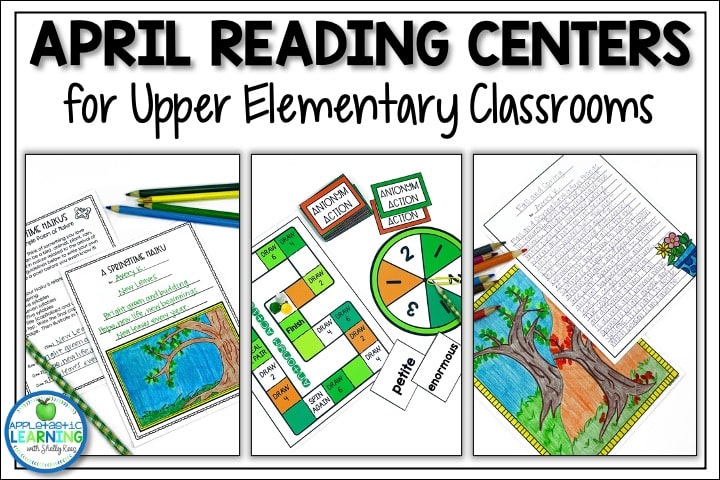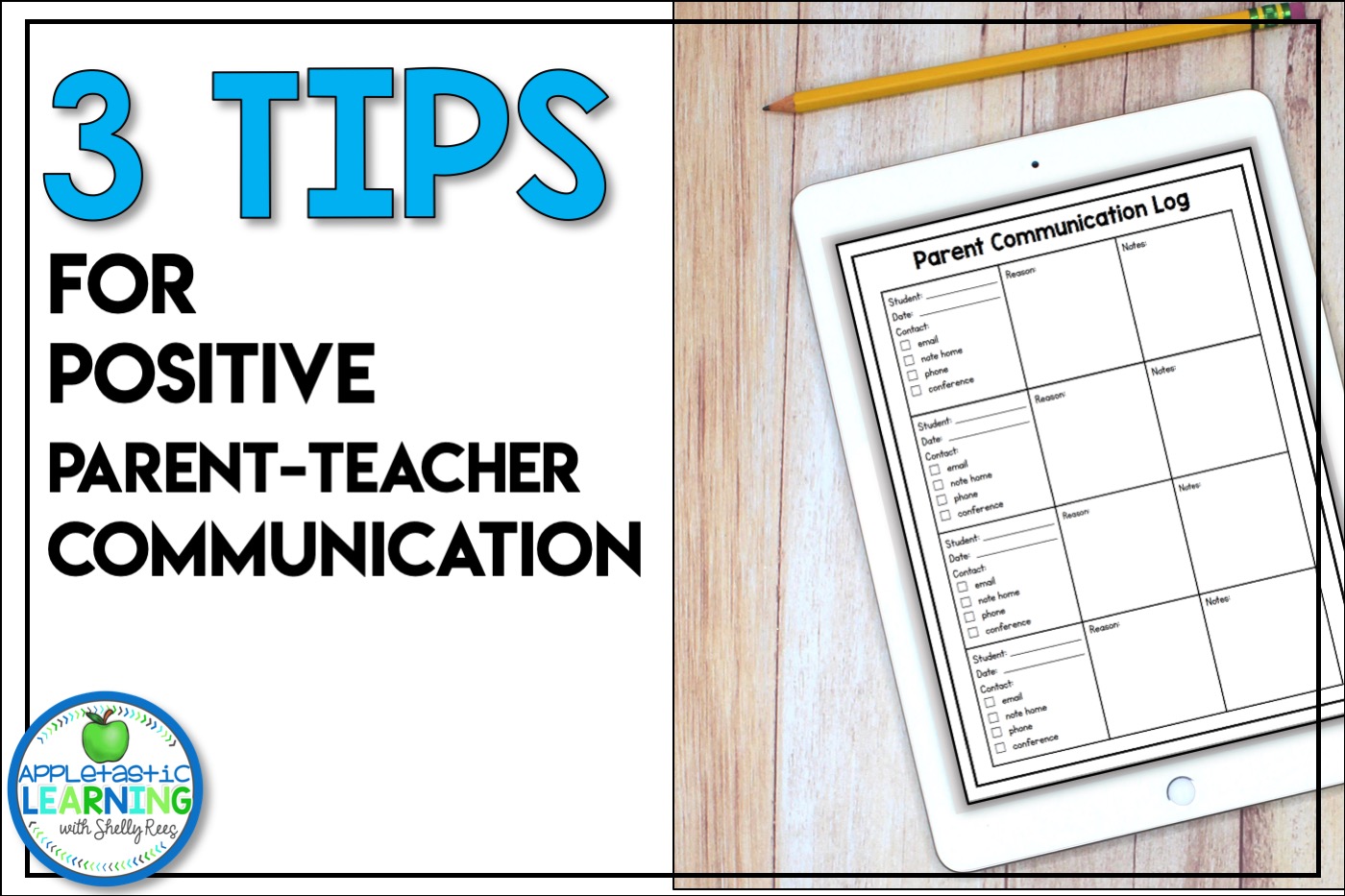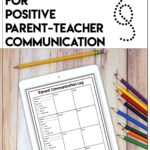

Communicating with parents is an important part of teaching, although many would say not the easiest or most fun. However, parent-teacher communication doesn’t have to be difficult or time consuming. It’s a great way to build and maintain a good relationship with your students’ parents. After all, everyone is on the same team – right? Here’s 3 parent-teacher communication ideas that are sure to help you stand out!
Communication is at the heart of relationships. It is based on communication that relationships can grow and flourish. Think for example about pen pals – two people who have never met in person yet through their communication have developed a friendship. For that matter, think about online dating – two people that start their relationship with communication. The parent-teacher relationship is kind of like these relationships too. It’s not a face to face, spend time to get to know you relationship. In fact, there are some parents that you might never meet in person. However, it’s an important relationship based on a common foundation – the student.
For some reason when teachers think about parent-teacher communication it is often in a negative sense. Having to call home about a behavior problem, missing work, or poor progress. These are all important and necessary reasons to have communication with a parent, but there is so much more to good parent-teacher communication.
Here’s a list of a few different things we should be communicating about:
One of the most important is what students are learning. Most parents will tell you that they care about their child’s education and that it is important. They want to be able to engage with their child about school, help their child how they can, and generally support the teacher. However, it’s just not feasible for them to come and sit in class everyday so they know what is going on. In fact, I’m not sure that we even want that. But they do want to know what is happening in the classroom.
Communicating with parents about the skills and topics that are being taught helps to make parents feel connected. It helps open conversations at home about what is happening at school. It allows for real world connections to be made as students see those skills or topics they learned about at school play out in everyday life – away from the classroom.
Ok – so this is just bonus – but it’s important too! It’s important to put yourself into the shoes of the parents. They want to help their kids, they know education is important, and they even know generally what topics are being taught. But they are not trained as educators and not sure what to do in order to connect that information to home. But you are! You can help the parents out by sharing one tip or trick they can use at home. Maybe its a super quick recap of how to simplify fractions, or maybe it is an educational game the family could play at home. Just share something you would do with your own child at home if they were in your class. These thoughts and ideas come more naturally to you than they do non-educators.
For example, instead of saying “this week we are learning about chemical reactions in science.” You might send home something like this: “Chemical reactions are at the front of our minds because that is what we are learning in science. Help your child see real chemical reactions in action at home. The kitchen is a great place to see chemical reactions. The next time you bake or cook as your child to help. Talk about how the ingredients are changing as they are mixed together, heated up or cooled down. Then remind them that these are real life chemical reactions.”
It only took a couple minutes longer to type that second option, but it gives the parents some helps and ideas of how they can be part of their child’s education and connect the school learning to home. Just think about the rich, experience filled discussions that can happen at school when the students are seeing their learning in real life.
Remember that part about having a negative view of parent-teacher communication? Well, that probably stems from the fact that teachers most often communicate with parents only when there is a problem. We have the power to break that cycle. We have the power to make parents look forward to our communications and not dread them.
I was once in a district where there was a requirement to make a positive call home during the first week of school for every student. The idea behind it is good, but if that is the only time you send positive communication it defeats the purpose. Everyone likes hearing good things and your students and their parents are no different.
By making an effort to send home positive communication for every student throughout the year we can help to change the perceived notion that teachers only communicate when something is wrong. Sending positive communication doesn’t have to take long or be time consuming. It can be a quick note, text, email or phone call just to say “I love teaching your child.” Here’s just a few things that are great for positive communication:
There’s really so much we can say about our students that is positive if we just look for it.
Try this 30 day challenge: For the next 30 school days, send home 2 positive communications a day. Not 2 for every student – just 2. Then just watch and see what happens. My guess is that there will be a direct correlation between improved student engagement and the time a positive communication was sent to that students parents. I also believe that students will be happier and more excited to come to class. And let’s not forget that we might learn more and connect better to our students because we are choosing to look for the good.
At the end of the 30 days see where things are. If you don’t think it has helped to improve parent-teacher communication overall then stop. But maybe, just maybe, it will become a habit that you don’t want to stop. Maybe, just maybe, you will be the teacher who stops the cycle.
It’s important to keep track of the communication you have with parents. You never know when you will need it to show an administrator, as data to show academic or behavioral improvement, or as part of a parent meeting or parent conference. Keeping track of communication can be as easy as keeping copies of notes, a quick call log, or even a parent communication binder. It plays a part into the big picture we have about our students and their overall progress in the year.
Keeping track of communication does not have to be difficult or take a lot of time. The key is being organized and keeping your system handy. I created a parent-teacher communication binder that always stayed on my desk near the telephone. It was always in the same place so I could grab it when I made a phone call. I used it to keep copies of written communication and a log of verbal communication.
I took all of the forms I used for my parent-teacher communication binder and put them together in this resource.
Here’s a glimpse at a couple of the forms I used. There are more too! You can choose the ones that work best for you and your classroom. There are whole class options and individual student options. There are daily options, weekly options or non-dated options. They are so fast and easy to fill out. No need to create a transcript of the conversation – just a few notes will do the trick. The hardest part is just getting used to doing it.
Today, it would be so easy to keep a digital binder too! Using an app like Notability, or others that let you write or type onto a pdf file, you can use these same logs and keep them on your tablet or phone. There are lots of options. How you do it is not near as important as just doing it.
Do you have some great parent-teacher communication methods? Share them in the comments or tag me on social media!
Just pin this to your favorite classroom Pinterest board so that you can come back later when you are ready to up your parent-teacher communication game!

Hi, I’m Shelly! Thank you for being here. I love helping third, fourth, and fifth grade teachers with fun and engaging activities that require no to little prep! Let me help you by taking some of the stress and work off your plate.

©2022 Shelly Rees. All Rights Reserved.
